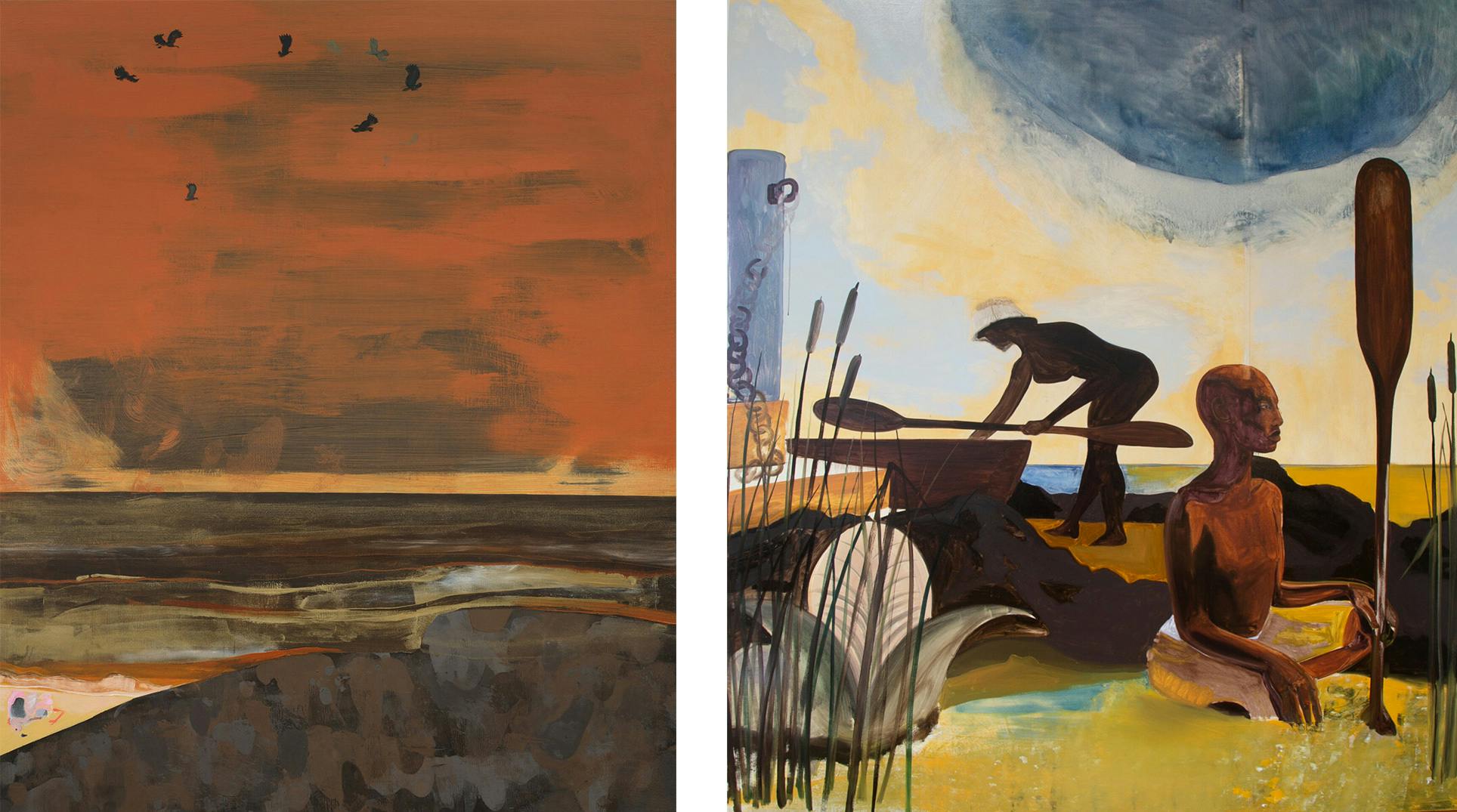Published October 10, 2022
Exploring Magical Realism with Nathaniel Oliver
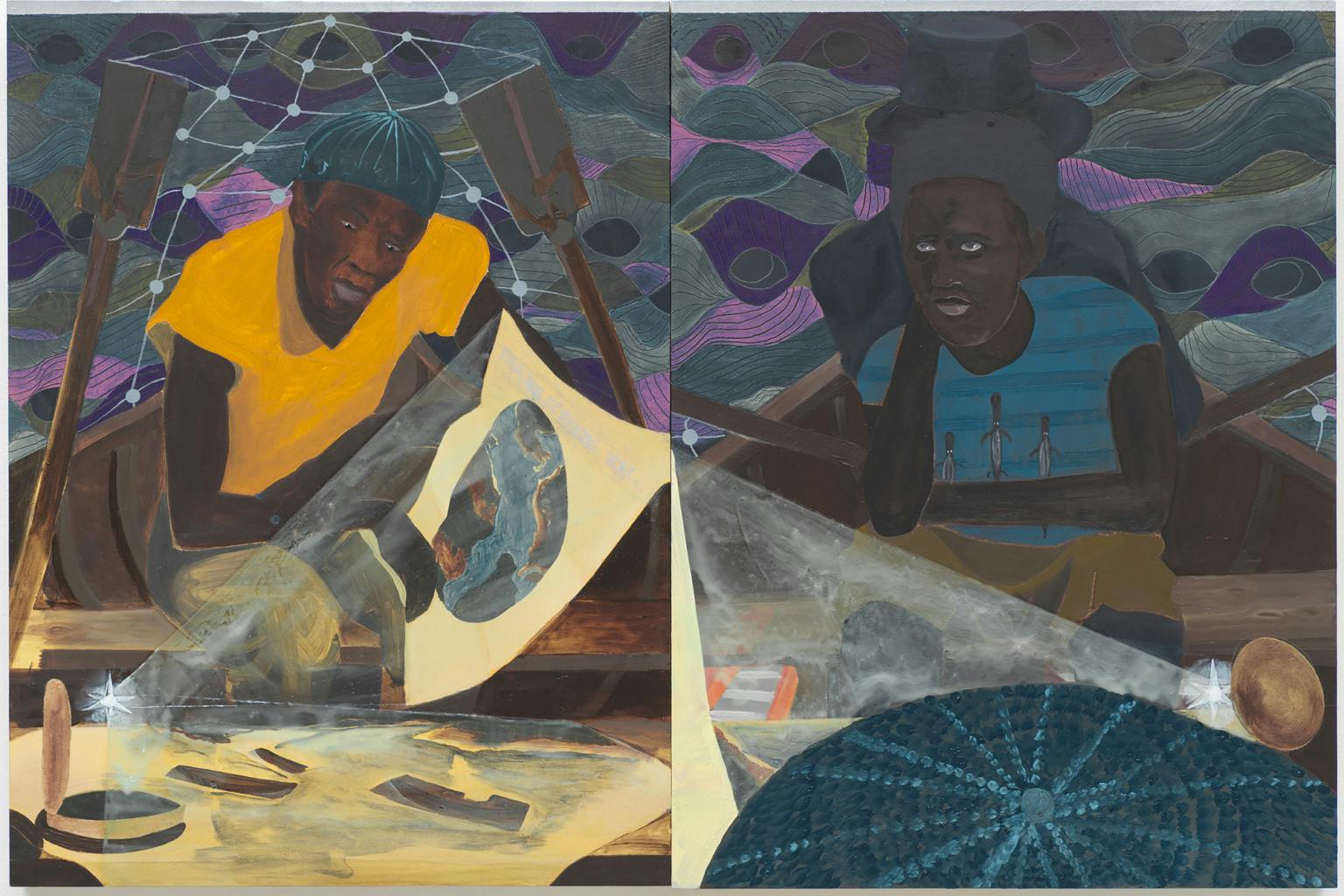
Nathaniel Oliver is a multidisciplinary artist working primarily in painting. Using oil on canvas and wood panels, his vibrant—and often uncanny—works explore notions of “truth discovery” through magical realism, an approach that is inspired by the everyday and informed by music, science fiction, and his upbringing in Washington, D.C.
In 2020, Oliver debuted his solo show, “Limbo,” at HOUSING, a gallery established by curator KJ Freeman championing Black, queer, and artists of color. Since then, Oliver has showcased widely and participated in major international art fairs: the Armory, Frieze, and Basel across New York, Miami, London, and more.
Oliver holds a Bachelor of Fine Arts from the Rhode Island School of Design (RISD). Based in New York City, he is newly represented by KARMA.
Oliver and I first met as students at RISD. In this exchange (a month-long correspondence over several time zones), we caught up on his recent Armory showcase, evolving practice, and creative process.
The conversation has been condensed and edited for clarity.
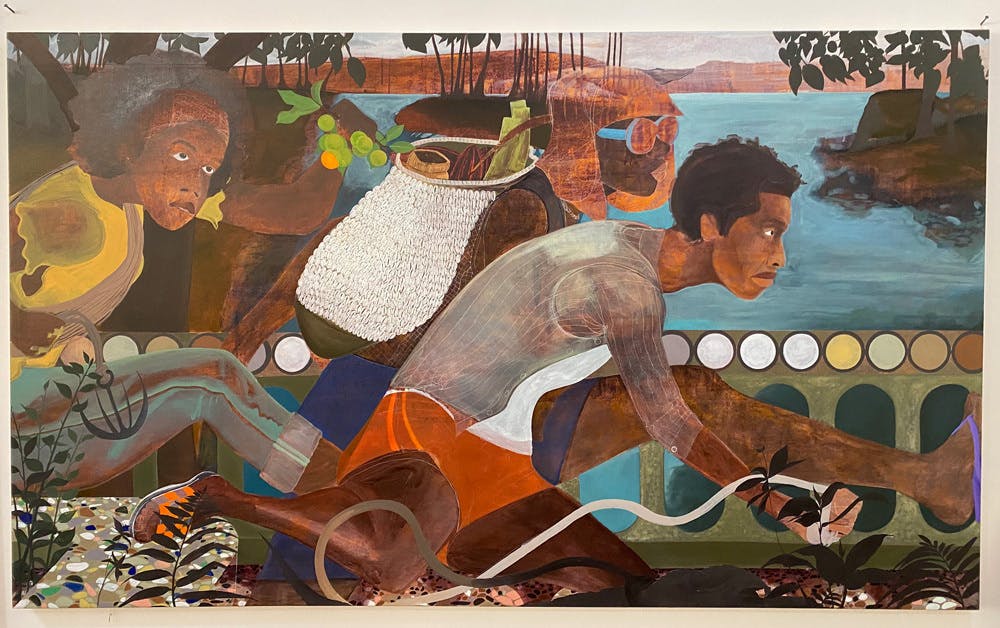
Congratulations on your second sold-out Armory show with HOUSING! This follows your presentation at the Independent Art Fair with Karma Gallery in May, with whom you’ll also showcase at Frieze London. What has your experience been like at these large-scale commercial events? How do you see the role that they play in an artist’s practice?
NO: Thank you, I am overly excited to have this solo exhibit at the Armory. I view these events as a way to get my art in front of a larger audience. Showing with these platforms has informed my understanding of how my paintings function for other people. I think it’s unwise to put a lot of stock into one moment, but I think art fairs and festivals can push your career—and being able to showcase with diverse artists allows relationships between other artistic themes to form. These platforms can also help you understand art tropes, movements, and how your art plays in and out of those spaces.
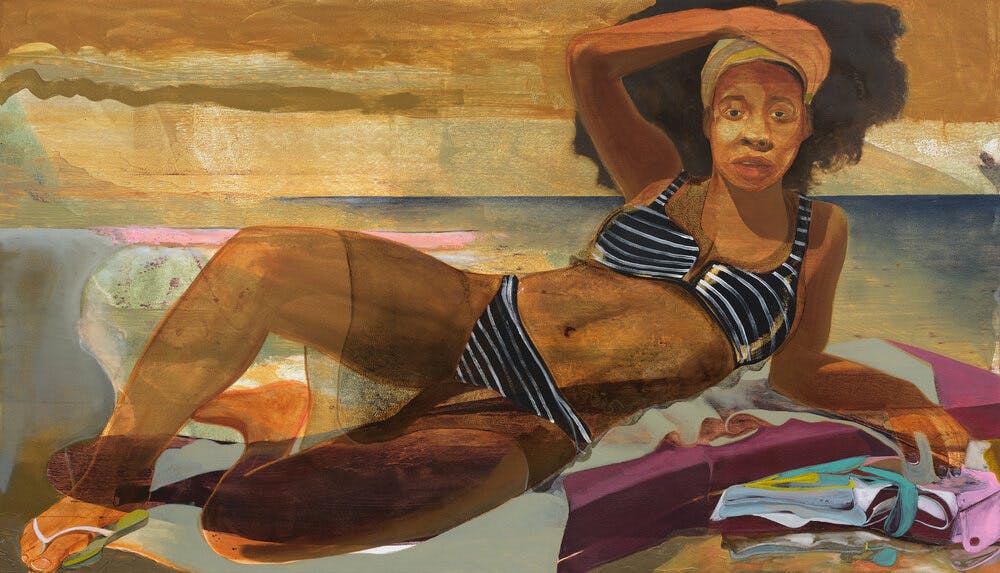
You’ve exhibited different series at each of these fairs. In what ways, or to what extent, do you think art fairs have influenced your approach to making new work?
NO: I wouldn’t go as far as to say each showing is a new series. The past exhibitions have been about ongoing themes from previous shows. The figures in my paintings are protagonists grappling with their varied situations as Black adventurers. For instance, both Further Together and We’ll Paddle From Here have a nonverbal exchange - there is a journey ahead of them. I am intrigued by the unspoken agreement expressed through the compositional relationships. Trust is the foundation of their engagement. Can they trust one another? Will we paddle from here further together or apart? This question then segues into notions of community and the faith it takes to build community. Another example of adventure, or better yet, the activation of adventure is Before It Finds You, Go Find It. In this painting, you see three adventurers on a boat in search of something that also has the skill to find them. Their situational awareness is captured by their posture and facial expression.
While fairs don't influence or dictate my creations, I’m delighted and sometimes astonished to see similar ideas captured by other artists. I think it speaks to the communal experience of existing. Moments like that remind me that no idea is your own.
I hope my motifs are an entry point for a multitude of people to derive a meaning. I like to think the motifs make the paintings multifaceted. Even the title has different meanings depending upon age and cultural backgrounds. You can’t solve my painting alone; you need other perspectives.
Absolutely. So how did you come to paint? Was there a pivotal moment that compelled you into pursuing being a full-time artist?
NO: I can’t actually remember my first time engaging with art, but there’s a baby picture where I’m holding a handful of brushes, crayons, and pencils. That picture was taken when I was about 2.
I was told I was always creative and had a desire for artistic expression. I discovered my interest in painting when I was about 14. I started taking art more seriously during my junior year at Duke Ellington School of the Arts. There wasn’t a pivotal moment; however, I attended the pre-college program at the Rhode Island School of Design the summer before my senior year solidifying my interest in pursuing this creative-art field.
The body of work you’ve exhibited at Armory and your Dune: Doom (2020) series share a similar rich, warm but subdued palette, and depicting scenes of being stranded on an island. The works often consist of figures who seem to be solitary (Ashore Beginnings, 2020) or who simply co-exist, independently from one another (We’ll Paddle From Here, 2021).
You’ve mentioned that your paintings illustrate space for both individual agency and community. How did this investigation begin and how has it developed over the years?
NO: Growing up as an only child, you have a head start in developing individual agency. I was my own adversary; I was my own obstruction. I learned from quite a young age that cause and effect were pragmatic—depending on my own efforts, I was either closer or further from my potential.
This investigation really started in my adolescence. I had a certain confidence to thrive for what I wanted against the odds. It’s a confidence I wouldn’t always see in my contemporaries. However, when they received positive reinforcement, beneficial results would follow. I was able to see clearly that an entire community could be moved by an individual with agency. It was quite inspiring, so I began implementing positive reinforcement for my friends and peers by speaking on what they can do rather than what they cannot do. This is depicted through aspects of my art showing figures moving forward, being progressive, going on adventures, and expanding their space and presence.
Before working independently full-time, you worked as a studio assistant for fellow artist, Derrick Adams. As an artist assisting another artist, how did you navigate that dynamic of collaboration with Adams, who has a very different and distinct aesthetic?
NO: I was a studio assistant but not a collaborator, so one of the biggest things to remember in these dynamics is that these experiences provide an introspective understanding of an artist’s life. I learned that the studio is not a location but a mindset.
Working with Derrick has shown me how devoted you have to be to pursue this art career. Derrick has a mastery of gathering imagery and meaning from everyday life and celebrating its presence and role. There was always this ease in Derrick’s art-making process. It felt formulaic. He was very good at making art in a way that allowed other hands to help the process without it feeling overwhelmed. Working with him helped me with my own studio practice. The only challenging part for me was making sure I didn't employ his cues and directions in my own expression.
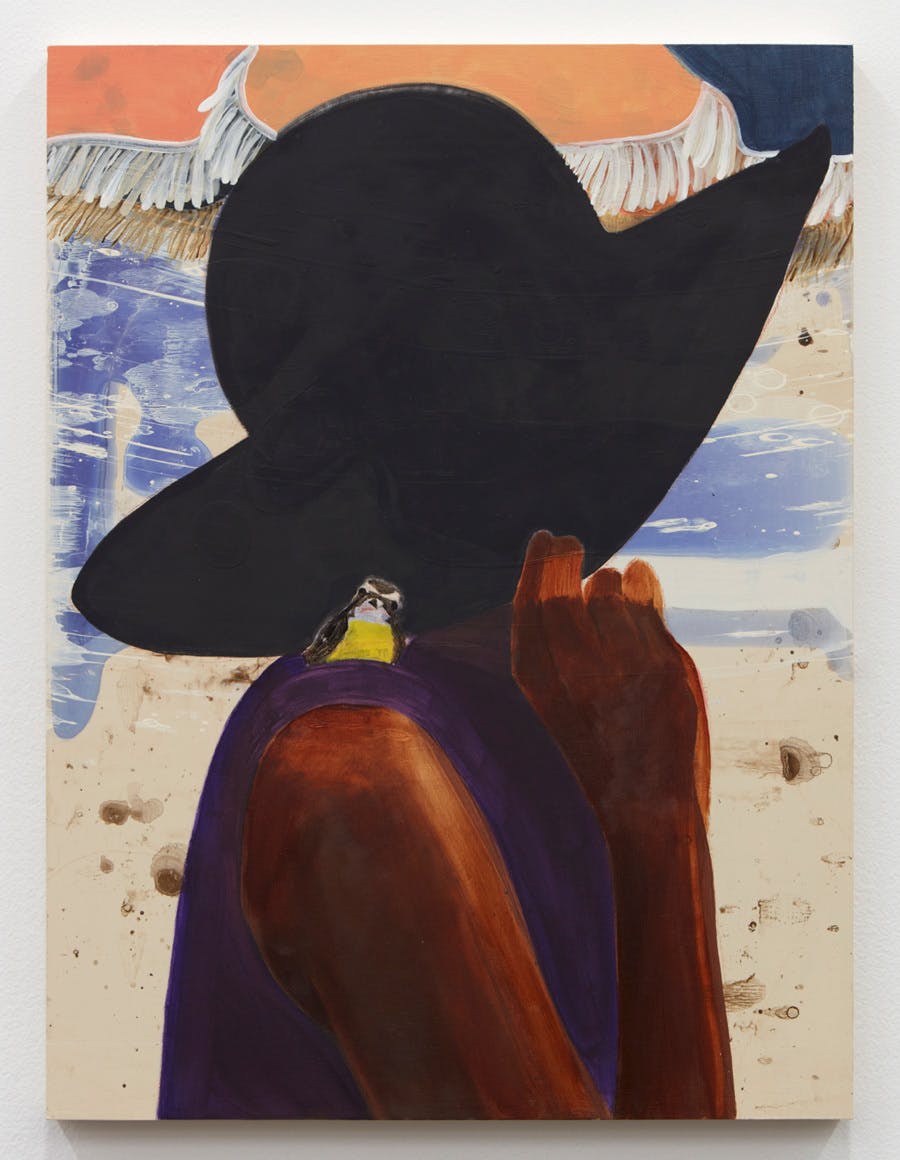
Magical realism is something you mention your practice explores. I feel that many of your evocative titles (such as You Can Smell the Storm, 2022) also hint at this quality. What exactly does magical realism mean to you and how does your work seek to manifest it?
NO: Magical realism means a great deal to me; even the term itself excites me. An imbalance of the two can drastically change a narration. You can magnify either imaginary or factual events.
I think about another painting of mine, Ashore Beginnings. Initially, I depict an imaginary space by preserving arbitrary moments from prior broader strokes. The strokes transform and become both figure and landscape. I then further render the figure so that it is more distinguishable. Later notes of realism are established from details like the suitcase that’s been flipped open and washed ashore—object holds a realness. The objecthood of the suitcase conveys revelatory experiences and memories. Ashore Beginning in relation to You Can Smell the Storm has a similar uncanny feeling.
There are separate elements from You Can Smell the Storm that I believe activate magical realism. Sensitivity to touch, indications of direction, and lighting are key components when making both paintings. In You Can Smell the Storm, the wind holds a magical presence while the bird on the figure's shoulder is a direct link to the ''real.” The bird is called a bananaquit and is the national bird of the Virgin Islands. The bird binds the painting to a specific location. If you know your birds, then you have a hint as to where figures are or could be in the world. With magical realism, I seek to manifest the emergence of communal ideas through the depiction of non-communal notions, which increases the number of advocates who cultivate new ways of thinking.
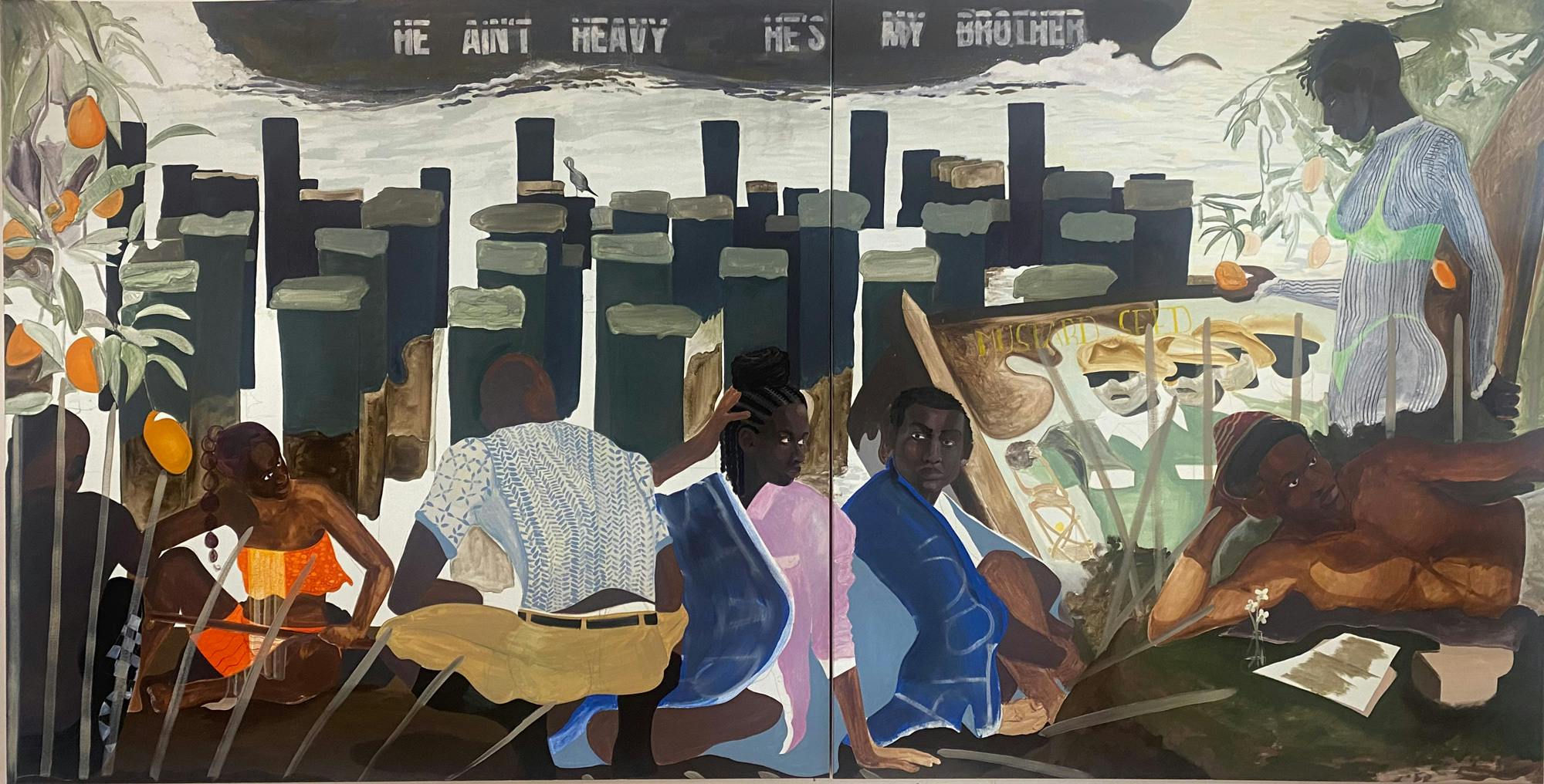
Your paintings are full of motifs and Biblical references - All Aboard the Mustard Seed (2022) is an example. What are some influences that have informed your visual vocabulary? And how do you hope people read your paintings?
NO: What I experience in everyday life, the conversations I have and hear, inspire my art. Outside of elevating the mundane, I look into things like science fiction, critical theory, and music for inspiration. The “Mustard Seed” is the only biblical reference in All Aboard the Mustard Seed. It’s written in yellow on the boat in the right panel. Biblically, it’s used to convey the growth of the kingdom of heaven and the act of faith. I aim to allude to a bigger conversation about quiet acts of service.
Heaven doesn’t just happen; it is made. Ideally, heaven is not tied to labor or work, although there is an entire production behind the idea of it. I perceive faith to be a quiet act of service; believing is visceral. I hope my motifs are an entry point for a multitude of people to derive a meaning. I like to think the motifs make the paintings multifaceted. Even the title has different meanings depending upon age and cultural backgrounds. You can’t solve my painting alone; you need other perspectives.
What are some topics and themes you’re excited about exploring next? How do you hope for your practice to evolve, grow, and develop?
NO: You'll have to follow the journey to see what comes next! I’m excited to explore new modes of expression and to continue challenging myself by reaching new heights in my ways of making. I also hope to refine my style and create more complex relationships in my art.
Oliver will be showing at Frieze London in October 2022 and Art Basel Miami in December 2022.
Testudo is always looking for more voices to write with us about the art world. If you’d like to pitch an article, please see our pitch guide for more information!
